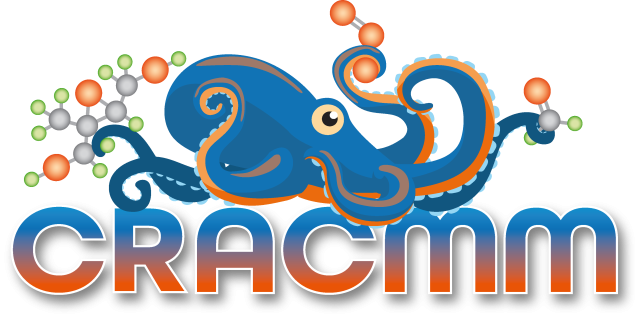CRACMM
The Community Regional Atmospheric Chemistry Multiphase Mechanism

EPA strives to ensure that the air quality models it uses – such as the Community Multiscale Air Quality (CMAQ) model – incorporate current state-of-the-science approaches. In air quality modeling, chemical mechanisms are used to represent atmospheric chemical reactions. How accurately the model makes predictions depends in part on how well those chemical mechanisms approximate the actual chemical processes in the atmosphere. Chemical mechanisms are continually updated to include newly discovered reactions, product yields, chemical properties, and other new advances as the state-of-science develops.
EPA scientists are leading a collaboration with researchers in the scientific community to develop the Community Regional Atmospheric Chemistry Multiphase Mechanism (CRACMM; pronounced CRACK-um). This chemical mechanism predicts multiple air quality endpoints, including ozone (O3), particulate matter (PM), chemical components of PM such as secondary organic aerosol (SOA), and toxics like formaldehyde (Pye et al., 2023). Reactive organic carbon (ROC) is one important focus of CRACMM’s development. ROC emissions have evolved over time as air quality regulations have been enacted. In the past, motor vehicles were the dominant emitters of ROC. Today, the relative dominance of ROC emissions has shifted with sources like volatile chemical products (e.g., paints, solvents, adhesives) and wood burning growing in relative importance. EPA is improving methods for chemically speciating ROC emissions and how their chemistry is represented in CRACMM.
The first version of CRACMM (CRACMMv1) was released in CMAQv5.4 in 2022. In work by Place et al. (2023), CRACMMv1 was applied over the northeast U.S. in summer, and ozone predictions were lower than those estimated by the Regional Atmospheric Chemical Mechanism (RACM2_ae6), which better matched surface network observations in the Northeast US (RACM2_ae6 mean bias of +4.2 ppb; CRACMMv1.0 mean bias of +2.1 ppb). In addition to the base version, a graph-theory based condensation of isoprene chemistry in CRACMM1AMORE was able to represent the chemistry of over 400 species in 800 reactions with only 12 species and 22 reactions (Wiser et al., 2023). More information about CRACMM and the timeline for development are available in fact sheets.
CMAQv5.5 (2024 release) includes an updated version of CRACMM—CRACMM version 2. CRACMM2 updates focused on improving predictions of formaldehyde and understanding implications for inhalation risk. CRACMM2 updates include a new treatment of isoprene chemistry from AMOREv1.2 as well as better consideration of monoterpene structure diversity in terms of oxidation products (Skipper et al., 2024).
2021 Fact Sheet:
2023 Fact Sheet Reflecting New References and CMAQ Schedule through 2026:
2024 EPA-NOAA CRACMM Collaboration White Paper
The CRACMM Collaborative Effort (pdf)
Publications:
Place, B. K., Hutzell, W. T., Appel, K. W., Farrell, S., Valin, L., Murphy, B. N., Seltzer, K. M., Sarwar, G., Allen, C., Piletic, I. R., D'Ambro, E. L., Saunders, E., Simon, H., Torres-Vasquez, A., Pleim, J., Schwantes, R. H., Coggon, M. M., Xu, L., Stockwell, W. R., and Pye, H. O. T.: Sensitivity of northeastern US surface ozone predictions to the representation of atmospheric chemistry in the Community Regional Atmospheric Chemistry Multiphase Mechanism (CRACMMv1.0), Atmos. Chem. Phys., 23, 9173-9190, https://doi.org/10.5194/acp-23-9173-2023, 2023.
Pye, H. O. T., Place, B. K., Murphy, B. N., Seltzer, K. M., D'Ambro, E. L., Allen, C., Piletic, I. R., Farrell, S., Schwantes, R. H., Coggon, M. M., Saunders, E., Xu, L., Sarwar, G., Hutzell, W. T., Foley, K. M., Pouliot, G., Bash, J., and Stockwell, W. R.: Linking gas, particulate, and toxic endpoints to air emissions in the Community Regional Atmospheric Chemistry Multiphase Mechanism (CRACMM), Atmos. Chem. Phys., 23, 5043-5099, https://doi.org/10.5194/acp-23-5043-2023, 2023.
Seltzer, K. M., Rao, V., Pye, H. O. T., Murphy, B. N., Place, B. K., Khare, P., Gentner, D. R., Allen, C., Cooley, D., Mason, R., and Houyoux, M.: Anthropogenic secondary organic aerosol and ozone production from asphalt-related emissions, Environmental Science: Atmospheres, https://doi.org/10.1039/D3EA00066D, 2023.
Skipper, T. N., D'Ambro, E. L., Wiser, F. C., McNeill, V. F., Schwantes, R. H., Henderson, B. H., Piletic, I. R., Baublitz, C. B., Bash, J. O., Whitehill, A. R., Valin, L. C., Mouat, A. P., Kaiser, J., Wolfe, G. M., St. Clair, J. M., Hanisco, T. F., Fried, A., Place, B. K., and Pye, H. O. T.: Role of chemical production and depositional losses on formaldehyde in the Community Regional Atmospheric Chemistry Multiphase Mechanism (CRACMM), Atmos. Chem. Phys., 24, 12903–12924, https://doi.org/10.5194/acp-24-12903-2024, 2024.
Vannucci, P. F., Foley, K., Murphy, B. N., Hogrefe, C., Cohen, R. C., and Pye, H. O. T.: Temperature-Dependent Composition of Summertime PM2.5 in Observations and Model Predictions across the Eastern U.S, ACS Earth Space Chem., https://doi.org/10.1021/acsearthspacechem.3c00333, 2024.
Wiser, F., Place, B. K., Sen, S., Pye, H. O. T., Yang, B., Westervelt, D. M., Henze, D. K., Fiore, A. M., and McNeill, V. F.: AMORE-Isoprene v1.0: a new reduced mechanism for gas-phase isoprene oxidation, Geosci. Model Dev., 16, 1801-1821, https://doi.org/10.5194/gmd-16-1801-2023, 2023.
